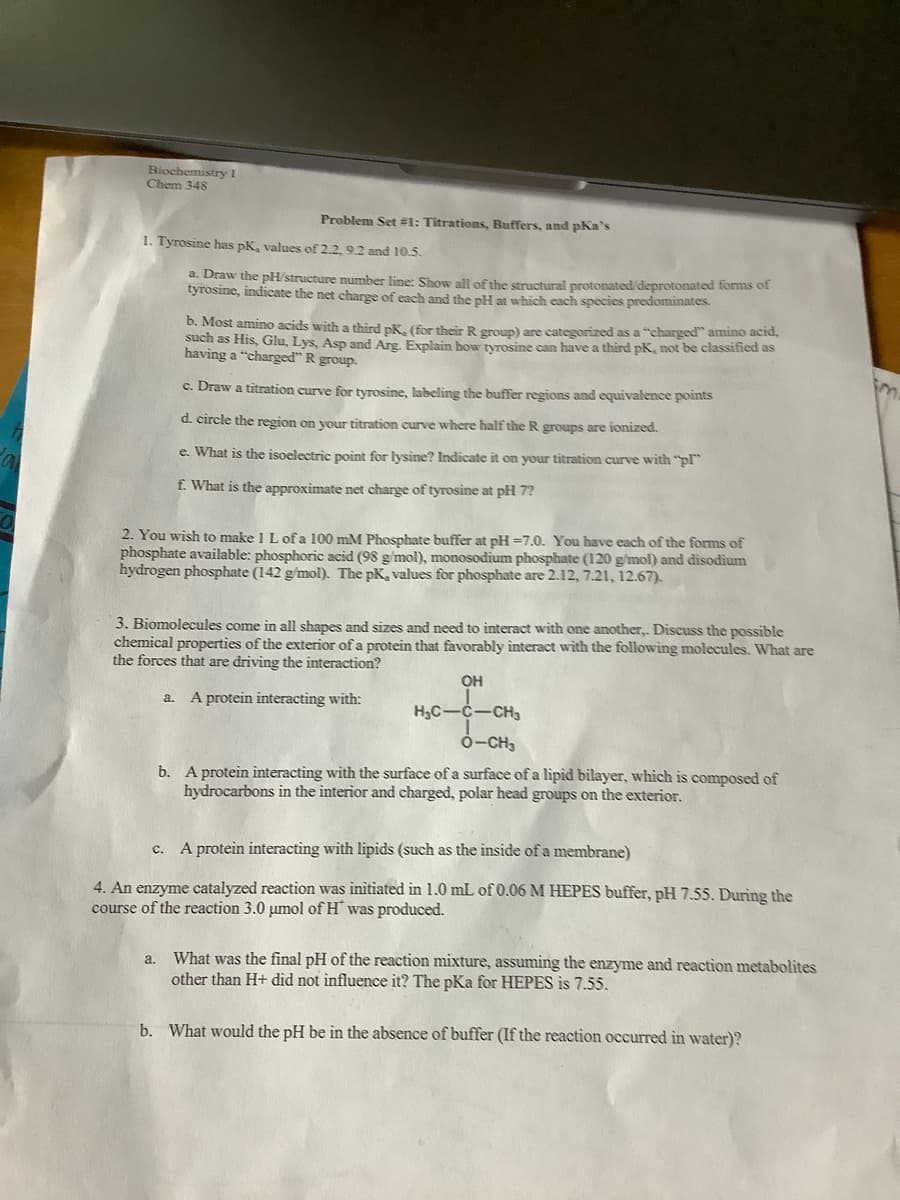1. Tyrosine has pK, values of 2.2, 9.2 and 10.5. a. Draw the pH/structure number line: Show all of the structural protonated/deprotonated forms of tyrosine, indicate the net charge of each and the pH at which each species predominates. b. Most amino acids with a third pK, (for their R group) are categorized as a "charged" amino acid, such as His, Glu, Lys, Asp and Arg. Explain how tyrosine can have a third pK, not be classified as having a "charged" R group. c. Draw a titration curve for tyrosine, labeling the buffer regions and equivalence points
1. Tyrosine has pK, values of 2.2, 9.2 and 10.5. a. Draw the pH/structure number line: Show all of the structural protonated/deprotonated forms of tyrosine, indicate the net charge of each and the pH at which each species predominates. b. Most amino acids with a third pK, (for their R group) are categorized as a "charged" amino acid, such as His, Glu, Lys, Asp and Arg. Explain how tyrosine can have a third pK, not be classified as having a "charged" R group. c. Draw a titration curve for tyrosine, labeling the buffer regions and equivalence points
Biology (MindTap Course List)
11th Edition
ISBN:9781337392938
Author:Eldra Solomon, Charles Martin, Diana W. Martin, Linda R. Berg
Publisher:Eldra Solomon, Charles Martin, Diana W. Martin, Linda R. Berg
Chapter3: The Chemistry Of Life: Organic Compounds
Section: Chapter Questions
Problem 2TYU: VISUALIZE The structures depicted are (a) enantiomers (b) different views of the same molecule (c)...
Related questions
Question
1abc

Transcribed Image Text:Biochemistry I
Chem 348
Problem Set #1: Titrations, Buffers, and pKa's
1. Tyrosine has pK, values of 2.2, 9.2 and 10.5.
a. Draw the pH/structure number line: Show all of the structural protonated/deprotonated forms of
tyrosine, indicate the net charge of each and the pH at which each species predominates.
b. Most amino acids with a third pK, (for their R group) are categorized as a "charged" amino acid,
such as His, Glu, Lys, Asp and Arg. Explain how tyrosine can have a third pK, not be classified as
having a "charged" R group.
c. Draw a titration curve for tyrosine, labeling the buffer regions and equivalence points
d. circle the region on your titration curve where half the R groups are ionized.
e. What is the isoelectric point for lysine? Indicate it on your titration curve with "pl"
f. What is the approximate net charge of tyrosine at pH 7?
2. You wish to make 1 L of a 100 mM Phosphate buffer at pH=7.0. You have each of the forms of
phosphate available: phosphoric acid (98 g/mol), monosodium phosphate (120 g/mol) and disodium
hydrogen phosphate (142 g/mol). The pK, values for phosphate are 2.12, 7.21, 12.67).
3. Biomolecules come in all shapes and sizes and need to interact with one another,. Discuss the possible
chemical properties of the exterior of a protein that favorably interact with the following molecules. What are
the forces that are driving the interaction?
a. A protein interacting with:
a.
OH
H₂C-C-CH3
Ó–CH3
b. A protein interacting with the surface of a surface of a lipid bilayer, which is composed of
hydrocarbons in the interior and charged, polar head groups on the exterior.
c. A protein interacting with lipids (such as the inside of a membrane)
4. An enzyme catalyzed reaction was initiated in 1.0 mL of 0.06 M HEPES buffer, pH 7.55. During the
course of the reaction 3.0 µmol of H" was produced.
What was the final pH of the reaction mixture, assuming the enzyme and reaction metabolites
other than H+ did not influence it? The pKa for HEPES is 7.55.
b. What would the pH be in the absence of buffer (If the reaction occurred in water)?
Expert Solution
This question has been solved!
Explore an expertly crafted, step-by-step solution for a thorough understanding of key concepts.
Step by step
Solved in 4 steps with 2 images

Recommended textbooks for you

Biology (MindTap Course List)
Biology
ISBN:
9781337392938
Author:
Eldra Solomon, Charles Martin, Diana W. Martin, Linda R. Berg
Publisher:
Cengage Learning

Biology (MindTap Course List)
Biology
ISBN:
9781337392938
Author:
Eldra Solomon, Charles Martin, Diana W. Martin, Linda R. Berg
Publisher:
Cengage Learning